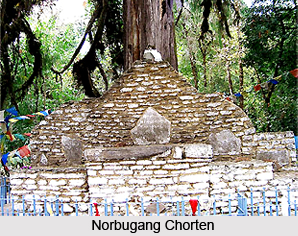 The Norbugang Chorten is situated in the Ghezing subdivision of West Sikkim district. It was constructed after the crowning of the first Chogyal of Sikkim in 1642 at Narbugong Coronation Throne near Yuksom. A holy lake known as Kuthok Lake is also associated with this place. The Chorten was the place where Lama Lhutsun Chempo created the time capsule by burying all the gifts to mark the occasion. Many Buddhist pilgrims visit Norbugang Chorten and the Norbugang throne as part of their pilgrimage tour.
The Norbugang Chorten is situated in the Ghezing subdivision of West Sikkim district. It was constructed after the crowning of the first Chogyal of Sikkim in 1642 at Narbugong Coronation Throne near Yuksom. A holy lake known as Kuthok Lake is also associated with this place. The Chorten was the place where Lama Lhutsun Chempo created the time capsule by burying all the gifts to mark the occasion. Many Buddhist pilgrims visit Norbugang Chorten and the Norbugang throne as part of their pilgrimage tour.
History of Norbugang Chorten
Norbugang Chorten was established during a consecration ceremony that was held by three learned Lamas headed by Lhatsun Chhempo, crowning the first Chogyal of Sikkim. Lhatsun Chhempo had suffixed his own surname of `Namgye` to Phunshog who was crowned the Chogyal and subsequently the king came to be known as Phunshog Namgyal. The crowning ceremony was performed by the lamas as per the procedures prescribed in the scriptures. Next the lamas decided to build the Trashi-wod-hBar-Chorten at Norbugang. Hence they collected earth and stones from different parts of Sikkim. They then built the chorten with the materials collected and also buried within it all the gifts that Lhatsun Chhempo had received from the people. This ceremony of benediction and consecration performed by the lamas lasted for 21 days.
Setting of Norbugang Chorten
The Norbugang Park has been made at Yuksom that is 42 km from Pelling town. It also houses a prayer hall, large prayer wheel, the Norbugang Chorten and the purported Coronation Throne set below a large cryptomeria pine. The wooden head board located near the throne is made of stone and appears like an altar. The Norbugang Coronation throne is made of stones. The stone throne has four seats, with the top one kept for Lama Lhatsun Chhempo. The coronation that took place under the pine tree is still present today. Norbung Chorten (stupa) is located next to the throne that contains water and soil from all parts of Sikkim. The small Kathok Lake`s waters were used for the consecration ceremony held to crown the Chogyal. A foot print seen here is attributed to be of one of the lamas involved in the crowning ceremony. By removing the head board, imprints are clearly seen of toes and soles of feet.



















